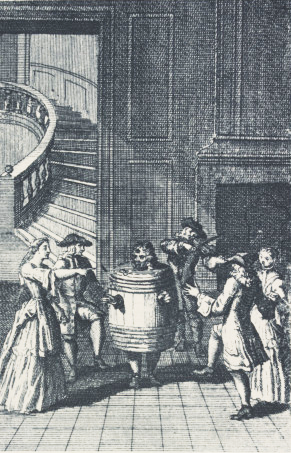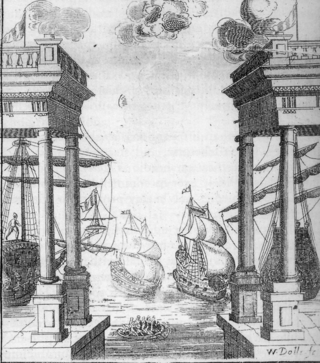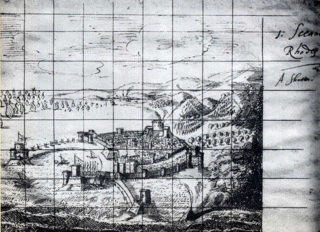Related Research Articles

"Restoration comedy" is English comedy written and performed in the Restoration period of 1660–1710. Comedy of manners is used as a synonym for this. After public stage performances were banned for 18 years by the Puritan regime, reopening of the theatres in 1660 marked a renaissance of English drama. Sexually explicit language was encouraged by King Charles II (1660–1685) personally and by the rakish style of his court. Historian George Norman Clark argues:
The best-known fact about the Restoration drama is that it is immoral. The dramatists did not criticize the accepted morality about gambling, drink, love, and pleasure generally, or try, like the dramatists of our own time, to work out their own view of character and conduct. What they did was, according to their respective inclinations, to mock at all restraints. Some were gross, others delicately improper.... The dramatists did not merely say anything they liked: they also intended to glory in it and to shock those who did not like it.

Sir William Davenant, also spelled D'Avenant, was an English poet and playwright. Along with Thomas Killigrew, Davenant was one of the rare figures in English Renaissance theatre whose career spanned both the Caroline and Restoration eras and who was active both before and after the English Civil War and during the Interregnum.
This article contains information about the literary events and publications of 1667.
This article presents lists of the literary events and publications in 1664.
This article contains information about the literary events and publications of 1663.
This article contains information about the literary events and publications of 1662.
John Crowne was a British dramatist.

The Restoration spectacular was a type of theatre production of the late 17th-century Restoration period, defined by the amount of money, time, sets, and performers it required to be produced. Productions attracted audiences with elaborate action, acrobatics, dance, costume, scenery, illusionistic painting, trapdoors, and fireworks. Although they were popular with contemporary audiences, spectaculars have earned a reputation from theatre historians as vulgar in contrast to the witty Restoration drama.

The Siege of Rhodes is an opera written to a text by the impresario William Davenant. The score is by five composers, the vocal music by Henry Lawes, Matthew Locke, and Captain Henry Cooke, and the instrumental music by Charles Coleman and George Hudson. It is considered to be the first English opera.

Heroic drama is a type of play popular during the Restoration era in England, distinguished by both its verse structure and its subject matter. The subgenre of heroic drama evolved through several works of the middle to later 1660s; John Dryden's The Indian Emperour (1665) and Roger Boyle's The Black Prince (1667) were key developments.

Elizabethan literature refers to bodies of work produced during the reign of Queen Elizabeth I (1558–1603), and is one of the most splendid ages of English literature. In addition to drama and the theatre, it saw a flowering of poetry, with new forms like the sonnet, the Spenserian stanza, and dramatic blank verse, as well as prose, including historical chronicles, pamphlets, and the first English novels. Major writers include William Shakespeare, Edmund Spenser, Christopher Marlowe, Richard Hooker, Ben Jonson, Philip Sidney and Thomas Kyd.
Gerard Langbaine was an English dramatic biographer and critic, best known for his An Account of the English Dramatic Poets (1691), the earliest work to give biographical and critical information on the playwrights of English Renaissance theatre. He is sometimes called Junior or the Younger to distinguish him from his father (1609–58) of the same name, a Doctor of Divinity who was Provost of The Queen's College, Oxford (1646–58) and Keeper of the University Archives.

The Dorset Garden Theatre in London, built in 1671, was in its early years also known as the Duke of York's Theatre, or the Duke's Theatre. In 1685, King Charles II died and his brother, the Duke of York, was crowned as James II. When the Duke became King, the theatre became the Queen's Theatre in 1685, referring to James' second wife, Mary of Modena. The name remained when William III and Mary II came to the throne in 1689.

Lisle's Tennis Court was a building off Portugal Street in Lincoln's Inn Fields in London. Originally built as a real tennis court, it was used as a playhouse during two periods, 1661–1674 and 1695–1705. During the early period, the theatre was called Lincoln's Inn Fields Playhouse, also known as The Duke's Playhouse, The New Theatre or The Opera. The building was rebuilt in 1714, and used again as a theatre for a third period, 1714–1732. The tennis court theatre was the first public playhouse in London to feature the moveable scenery that would become a standard feature of Restoration theatres.

The Duke's Company was a theatre company chartered by King Charles II at the start of the Restoration era, 1660. Sir William Davenant was manager of the company under the patronage of Prince James, Duke of York. During that period, theatres began to flourish again after they had been closed from the restrictions throughout the English Civil War and the Interregnum. The Duke's Company existed from 1660 to 1682, when it merged with the King's Company to form the United Company.
The Cruelty of the Spaniards in Peru was an innovative 1658 theatrical presentation, a hybrid entertainment or masque or "operatic show", written and produced by Sir William Davenant. The music was composed by Matthew Locke.
Edward Howard was an English dramatist and author of the Restoration era. He was the fifth son of Thomas Howard, 1st Earl of Berkshire, and one of four playwriting brothers: Sir Robert Howard, Colonel Henry Howard, and James Howard were the others. The brothers were sometimes confused in their own era, and Edward was sometimes given credit for his brother Henry's play The United Kingdoms.
Thomas Duffet, or Duffett, was an Irish playwright and songwriter active in England in the 1670s. He is remembered for his popular songs and his burlesques of the serious plays of John Dryden, Thomas Shadwell, Elkanah Settle and Sir William Davenant.

The Mock Tempest, or the Enchanted Castle is a Restoration era stage play, a parody by Thomas Duffet; it premiered in 1674, and was first printed in 1675 by the bookseller William Cademan. In creating his farce, Duffet's target was not Shakespeare's famous play, but the adaptation of it that John Dryden and Sir William Davenant wrote in the 1660s. According to critic Michael West, "There are frequent nautical metaphors, and 'more noyse and terrour than a Tempest at Sea'...."

John Dancer was an Irish dramatist, connected with the Theatre Royal, Dublin. His works consist of several translations from Italian and French, original plays, and some miscellaneous stories and poems.
References
- ↑ John Wilcox, The Relation of Molière to Restoration Comedy, New York, Columbia University Press, 1938; pp. 127-8.
- ↑ Gerard Langbaine, An Account of the English Dramatick Poets, London, 1691, pp. 99-100; quoted in Wilcox.
- ↑ Dane Fransworth Smith, Plays about the Theatre in England from The Reheasral in 1671 to the Licensing Act in 1737, London, Oxford University Press, 1936; pp. 7 and ff.
- ↑ André de Mandach, "The First Translator of Molière: Sir William Davenant or Colonel Henry Howard," Modern Language Notes, Vol. 66 No. 8 (December 1951), pp. 513-18.
- ↑ James Maidment and W. H, Logan, eds., The Dramatic Works of Sir William Davenant, Vol. 4, Edinburgh, William Paterson, 1873; p. 6.
- ↑ Robert D. Hume and Harold Love, eds., Plays, Poems, and Miscellaneous Writings Associated with George Villiers, Second Duke of Buckingham, 2 Volumes, Oxford, Oxford University Press, 2007; Vol. 1, pp. 341-2.